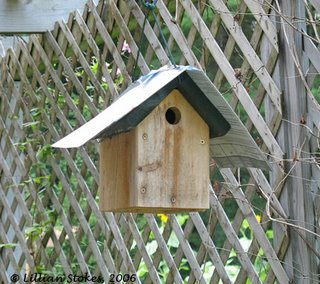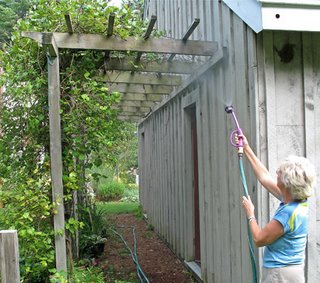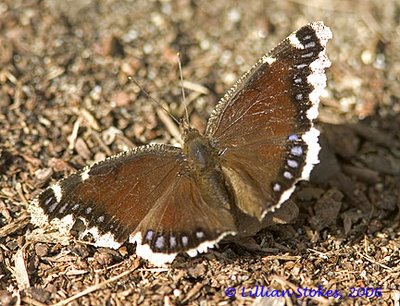 One of our favorite summer birding things to do in summer is to go see Atlantic Puffins off the coast of Maine. We have done this a number of times. There are several places to go, including Machias Seal Island. That's where I took the above photo. The best times are from June thru mid-August. You need to take a tour boat that has the permits to land there. When you land, you go to very small wooden shacks that are blinds with little windows that you can look out of, to photograph and watch the puffins close by. This is to create the least disturbance to the birds. It is an amazing thrill to see these little "Parrots of the Sea" up close and personal. Call in advance for the tours.
One of our favorite summer birding things to do in summer is to go see Atlantic Puffins off the coast of Maine. We have done this a number of times. There are several places to go, including Machias Seal Island. That's where I took the above photo. The best times are from June thru mid-August. You need to take a tour boat that has the permits to land there. When you land, you go to very small wooden shacks that are blinds with little windows that you can look out of, to photograph and watch the puffins close by. This is to create the least disturbance to the birds. It is an amazing thrill to see these little "Parrots of the Sea" up close and personal. Call in advance for the tours.Search This Blog
Tuesday, July 26, 2011
Puffin Fun
 One of our favorite summer birding things to do in summer is to go see Atlantic Puffins off the coast of Maine. We have done this a number of times. There are several places to go, including Machias Seal Island. That's where I took the above photo. The best times are from June thru mid-August. You need to take a tour boat that has the permits to land there. When you land, you go to very small wooden shacks that are blinds with little windows that you can look out of, to photograph and watch the puffins close by. This is to create the least disturbance to the birds. It is an amazing thrill to see these little "Parrots of the Sea" up close and personal. Call in advance for the tours.
One of our favorite summer birding things to do in summer is to go see Atlantic Puffins off the coast of Maine. We have done this a number of times. There are several places to go, including Machias Seal Island. That's where I took the above photo. The best times are from June thru mid-August. You need to take a tour boat that has the permits to land there. When you land, you go to very small wooden shacks that are blinds with little windows that you can look out of, to photograph and watch the puffins close by. This is to create the least disturbance to the birds. It is an amazing thrill to see these little "Parrots of the Sea" up close and personal. Call in advance for the tours.Friday, July 22, 2011
Hot Weather Help for Birds: 10 Tips to Keep Them Cool
Birds need water to drink,
and bathe.
"Hey, where's the towel and the frozen daquiris?"
An extra roof cools off the bird house below.
This baby American Robin cooled off the only way it knows how, by panting. Birds have no sweat glands and so cool themselves by rapid respiration with their mouths open
I used the mister setting on the hose to cool off the robin nest by misting the air and foliage above.
Hummingbird Feeder with shade roof
In this extremely hot weather gripping much of the nation, here's some tips to keep your feathered buddies cool:
a bird bath. You can even use any wide flat container for a bird bath, such as the lid of a trash can or a large saucer that it used under a flowerpot.
2. Choose a bird bath that is shallow and has a non-slip surface. Small birds do not like to bathe in deeper water. You can add flat rocks to a bird bath that is too deep in order to create a shallow ledge for small birds to land on to drink and bathe.
3. Add a dripper, bubbler or to your bird bath. The sound of moving water will be a magnet for the birds and alert them to the presence of a water source.
4. Keep the water in your bird bath cool by adding ice cubes several times a day, or refilling
the bird bath with a hose.
5. Birds will feel safer if the bird bath is placed in a more open area so no predators can hide nearby. Provide a stake or branch placed in the ground near the bird bath, if no landing places exist near it, so birds have a place to wait their turn at the bath.
6. Air condition your bird houses. We nail on a piece of plywood, using long nails and only nailing them part way into the original roof. This leaves an airspace between the two roofs of about an inch. The second roof shades the first roof plus the airspace between the roofs acts as an insulator, keeping the bird house cooler. In some cases we have just shaded the roof of a bird house with piece of cardboard.
7. Misters are coolers. Misters can be bought to attach to a bird bath, or clip to shrubs near a bath. They spray a fine mist that birds can fly though, or rub against the wet shrubbery. Hummingbirds will often fly through misters, or even a garden sprinkler.
8. Use a mister on a hose. Our hose has a mist setting on the nozzle. We have misted the foliage and area above a robin nest to cool off the babies in extreme heat.
9. Think Shade. Birds will seek out shady areas and lie low in the worst heat of the day. If you do not have shade on your property plant some shade trees and big shrubs. Place bird feeders in a shady area during summer.
10. Shade hummingbird feeders. Place them in shade. Some feeders, such as our Stokes Select Jubilee Hummingbird Feeder, pictured above, comes with its own shade/rain roof, including and ant moat on the roof. You can buy also by baffle-type shields and hang them above a feeder. Don't forget to change your hummingbird nectar solution every 2 days in really hot weather.
And tips for you....
Stay out of the sun and heat in the middle of the day, wear a hat and sunscreen when you do go out, and at the end of the day, after you have taken care of the birds, have a cold beer or some Prosecco,,,aaahhh!
Tuesday, July 19, 2011
Butterflies for Birders

Monarch Butterfly. They lay their eggs on milkweed and their caterpillars feed on this plant.
American Lady Butterfly, told by the two eye spots on underside of the hindwing

Tiger Swallowtail Butterflies are unmistakable
Spicebush Swallowtails can be told from other big, dark swallowtails by their single row of prominent white dots inside the margin of their forewings.

Spicebush Swallowtail underside. This Spicebush Swallowtail was sipping nectar from our purple bee balm flowers right in front of our deck. You can see the long mouthpart extending into the tube. The larvae of Spicebush Swallowtails feed on spicebush and sassafrass.

Pearl Crescent butterfly. Scores are feeding on white clover on our path so we keep the path mowed high to preserve the clover flowers for them.
Mourning Cloaks are widespread across much of North America. They are one of the few butterflies who overwinter as adults, finding protected places in log piles, nooks, or under loose bark, and when they emerge in the spring they look worn, as this butterfly does. They are one of the longest lived butterflies and some may live as long as 10 months. Mourning Cloaks feed on sap and fruit.
 Our butterfly bushes will bloom soon and they're magnets for the butterflies. Here's a Great Spangled Fritillary butterfly on one of them.
Our butterfly bushes will bloom soon and they're magnets for the butterflies. Here's a Great Spangled Fritillary butterfly on one of them. 
We've written two books to help you attract and identify butterflies. Stokes Beginner's Guide To Butterflies, has an easy ID key to help you quickly identify the butterflies you see by size and shape.
 Stokes Butterfly Book gives you plans for a butterfly garden, lists and photos of butterfly plants, and chapters, with color photos, on the identification, behavior and caterpillars of common butterflies. Both are available at amazon.com and stores.
Stokes Butterfly Book gives you plans for a butterfly garden, lists and photos of butterfly plants, and chapters, with color photos, on the identification, behavior and caterpillars of common butterflies. Both are available at amazon.com and stores.When the birding is slow, and it's the middle of the day, a wonderful thing for birders to do is look for butterflies. Butterflies are colorful flying creatures, just like birds. The identification skills birders already have can be transferred to identifying butterflies.
Look at butterflies through your binoculars, no need to catch them in a net.
The hot weather favors butterflies as they need to warm their bodies to fly. They need to get their body temperature up to 85 to 100 degrees Farenheit in order to fly well. Adult butterflies come to flowers for nectar, lay their eggs on special host plants, which can be unique to each species of butterfly. The eggs hatch, larva feed on the plant then turn into a pupa or crysalis from which the adult butterfly will emerge. A complete cycle or generation is called a brood, and butterfly species can go through from just one to as many as four broods per year, depending on the species and the number of warm months. Different butterflies are on the wing at different times during the summer, so you will continue to see new species.
There are about 17,000 species of butterflies in the world. In North America there are about 700 species but only a small fraction are common and likely to be seen by the average person.
When you see a butterfly watch it closely for several minutes. Observe how it flies, its size, shape, and the colors and patterns on its wings, both above and below.
Start by knowing the major families of butterflies that are distinctive. Below are some:
Swallowtails - are our largest butterflies and most have long tails coming off their hind wings.
Whites and Sulfurs - these are all medium-sized butterflies that are predominantly white or yellow.
Gossamer Wings - this group is easy to identify since it includes all of our smallest butterflies, such as the blues, coppers and hairstreaks, and metalmarks. The blues tend to be iridescent blue, coppers are often copper, hairstreaks often have hairlike tails on their hind wings, and metalmarks often have metallic spots on their wings.
Brush-footed Butterflies - this is a large and varied group of medium-sized, generally dark-colored butterflies with such strong and rapid flight they are hard to follow. Their is no one field characteristic, besides their flight, that makes them easy to identify as a group.
Satyrs - these are medium-sized butterflies that are almost all brown, often with darker eye-spots on their wings. They have a weak and bobbing flight and are often seen at woods edges or among grasses.
Skippers - are small butterflies whose flight is extremely rapid and erratic. They are mostly rich brown or orange-brown.
Wednesday, July 13, 2011
Dragonflies for birders

Halloween Pennant dragonfly, so aptly named, and one of my favorites. We have hundreds in our fields right now.
 Widow Skimmer. The most colorful dragonflies with patterns on their wings are often in the Skimmer family of dragonflies.
Widow Skimmer. The most colorful dragonflies with patterns on their wings are often in the Skimmer family of dragonflies.When the birding slows down in summer and birds are quiet in the middle of the day, birders turn to watching dragonflies, that's what we do. Dragonflies are active on warm days, the hotter and sunnier the better. Dragonflies are stunningly beautiful, have cool names, and are abundant in fields, lakes, streams, shores, many of the places people go in summer.
Here are a few tips to enjoy and identify them.
1. Use your binoculars to spot them, if you have close focusing binos, even better.
2. Some dragonfly males patrol territories along ponds, lakes, and streams. Females mate with them then lay their eggs on emerging vegetation. If you see 2 dragonflies flying in tandem, this is a precursor to mating. In the wheel positon, mating is occurring.
3. Some dragonflies are more perchers, others more fliers, that can be a clue to their ID. Different perchers have different ways of perching, again an ID clue.
4. In general, some of the most obvious, colorful, and patterned-wing dragonflies you see are in the Skimmer family, so look in that section of our book.
5. Different species of dragonflies are on the wing at different times during the summer, so you will constantly see new ones.
6. Male, female and immature dragonflies of the same species can look different, just like birds.
We (along with dragonfly experts Blair Nikula and Jackie Sones) produced a book,Stokes Beginner's Guide To Dragonflies in order to quickly help you get into enjoying these marvelous insects. We worked out an easy key and lots of color photos. Take it and binoculars along with you the next time you go to the lake, river or stream. We take it with us in the canoe whenever we go out in the summer. Enjoy!
Friday, July 08, 2011
Robin Splish-Splash

Splish-Slpash-Splash

"Ahhh, that felt good!"
An American Robin enjoying our new bird bath, which has a bubbler in the center, is shallow, just deep enough, and has a non-slip bottom. That is why so many bird love it. By the way, most birds bathe in the same ritualistic way by dipping their heads, letting the water flow over their backs, then vigorously flapping their wings to drive the water under their feathers. Feather maintenance is soo important when you only have one pair of clothes,
Saturday, July 02, 2011
Subscribe to:
Comments (Atom)




















